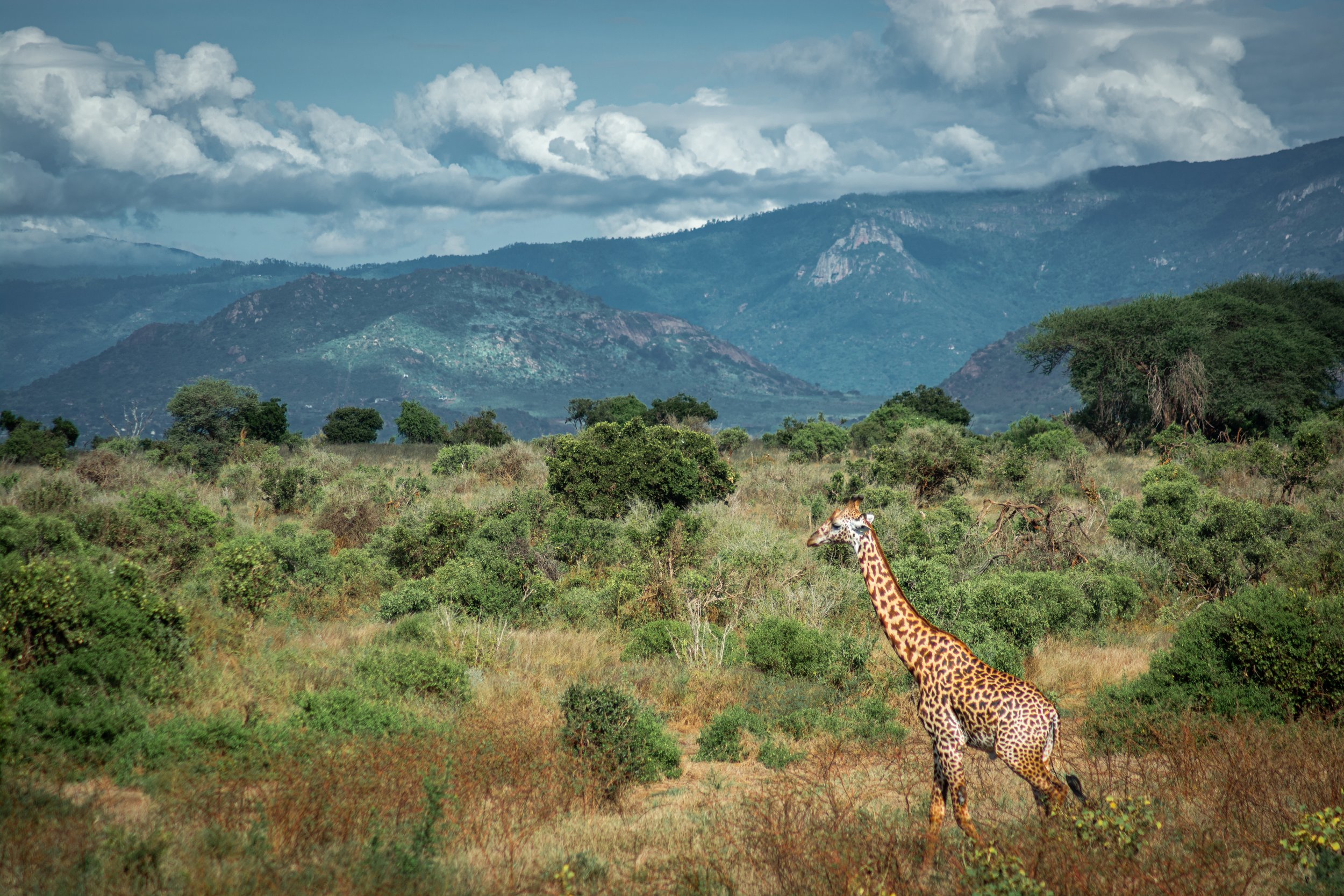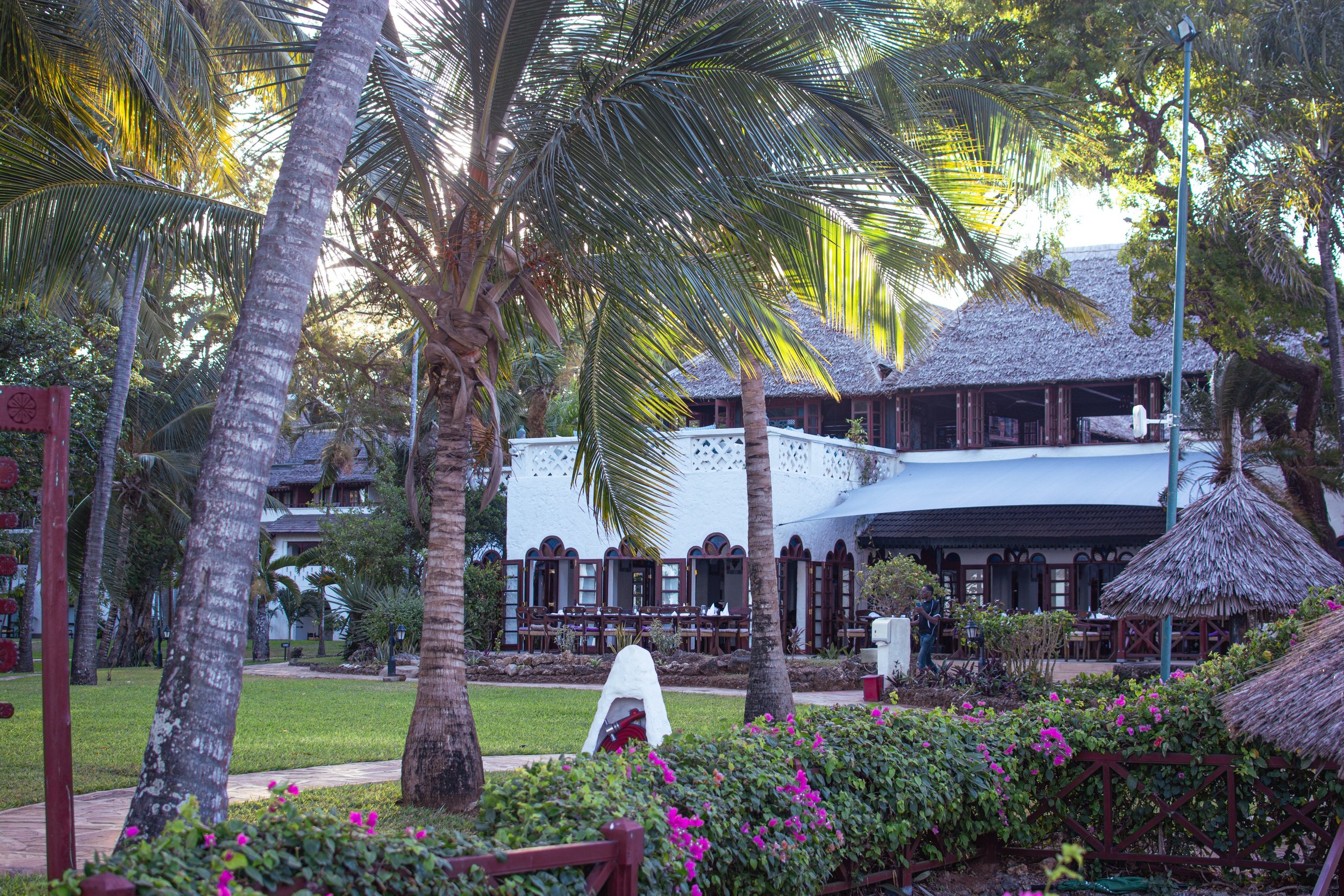Only on a Kenyan safari could you see an elephant wander freely past a football pitch
First published on MetroUK
Lunch time viewing at Kilaguni Serena Safari Lodge
I had just snapped a photo of an elephant wandering in the fields a few metres away from where a football match was being played, when a man in a truck pulled up next to me and pointed at my camera.
Through a grin as wide as the Great Rift valley, he shouted: ‘When you post that photo, make sure you write “only in Africa”.’
I had seen lions, elephants and giraffes, explored sacred forests and watched beautiful sunsets throughout my trip to Kenya, but nothing turned my head so quickly, or encompassed the sheer awe and unique beauty of this country more than that moment.
An elephant passing by a football match
Monkeys roam freely all across Kenyan’s safari lodges
There’s a sense in Kenyan culture – far removed from the hustle and bustle of the West – that all will work out, one immortalised in media as the Swahili phrase Hakuna Matata. Will it rain today? We don’t know, we’ll make do. A delayed flight? No worries, you’ll get to your destination eventually. No lion sightings today? Never mind, let’s try again tomorrow.
Even an elephant as your backdrop while having a kick about brings a wry smile from the locals, a matter-of-fact attitude that this is Kenya, this is Africa, all is as it should be, and the unexpected is the only thing that is expected.
On a safari journey
I had just finished four days of a safari trip as part of a Tui package to Kenya billed as a cheaper and more accessible travel package for those looking to explore the country’s famed nature reserves.
The concept offers travellers a taste of the Kenyan coast and the majesty of its national parks with all the scenery, wildlife and culture that make this part of the world so special.
You have to accept what you get on safari
To experience a safari (a Swahili word meaning ‘journey’) is the most spectacular example of having to accept what you get you get. On some game drives, we were searching the horizon – every tree and shade of grass – for any sight of some of Kenya’s most famous animals. Sometimes hours might go by when it’s just you, your jeep, and the Kenyan wilderness.
But that can all change in an instant.
One day into our safari in the tranquil Tsavo East National Park, our driver Jimmy (who had the cool air about him of a prime poker player) suddenly reversed away from where we had been observing an elephant to speed back down the road. He had just been radioed that a lioness and her cubs had come out of the long grass.
The beautiful lion cubs
A lioness and her cubs in a rare safari sighting
Seeing a tiny lion cub in the wild roar a beautifully pathetic roar in front of its siblings, golden fur and deep orange eyes and all, was a moment that took our breath away, locked it somewhere five minutes down the road, and didn’t return it to us until the lions had finally disappeared back within the grass.
Such sightings are rare, but that’s why you take the risk and go on a safari: for moments like that.
A giraffe in the spectacular Tsavo East
The Tsavo elephants look red, but this is just due to them dust-bathing in the park’s vibrantly red soil
Flamingos in front of Mt Kilimanjaro
The incredible backdrops of Tsavo East
Much more frequent sightings include elephants, giraffes, wildebeests, antelopes and a variety of exotic birds (you haven’t seen anything until you’ve seen a secretary bird doing its best Monty Python silly walk impression).
We even found numerous hippos yawning their gigantic heads out of the water before splashing them back down again.
There’s no guarantee to see anything, but the fact we were no longer surprised to spot elephants two days into our trip reflects how likely it is that you are to come across them.
Beyond the animals
However, safaris are more than just the wildlife. For every ‘big five’ animal you don’t get to see is an awe-striking vista; miles of yellow grass plains basking in the golden dawn rays and mountains stretching out behind every tree.
There are a variety of incredible lodges to make the most of Kenya’s parks, and TUI have picked some of the most beautiful.
The rustic verandas outside each room of the Ashnil Aruba Lodge offer a serene Tsavo East sunrise every morning, with huge flutters of birds flying over the trees surrounding it. The only thing missing is a Hans Zimmer score.
Waking up to a Kenyan sunrise at Ashnil Aruba Lodge
Meanwhile, the Kilaguni Serena Safari Lodge, with its cathedral-like dining space facing out over a watering hole and backdropped by mountains upon mountains, is something out of a photographer’s dream.
But the crowning glory of Kenya’s safari accommodations is undoubtedly Salt Lick in Taita Hills. A small colony of Swiss-like towers on stone stilts, connected by wooden suspension bridges over a small lake, it’s as unique a lodge design that I have ever seen.
Elephants next to football pitches and lion cubs aside, possibly my favourite moment of the trip was waking up to see the sun rise up from Salt Lick’s rooftop bar.
The spectacular design of Salt Lick Safari Lodge
To a soundtrack of crickets sleeping and birds awakening, with rows of deep blue mist stretching right back across the fields to the mountain tops, the sun, majestically, began to reveal itself.
With a coffee in hand, I stared at the rays reflecting over the water as elephants began to make their way to drink. I knew I had never experienced a morning quite like that, and am unlikely to ever do so again.
Coastal living
TUI’s package picks the coastal region surrounding the city of Mombasa as the trip’s ‘sit-back-and-relax’ location and has a list of serene resorts and hotels to stay at (as well as featuring some of Kenya’s most interesting cultural experiences).
Mombasa, which means ‘fighting island’, is a busy city featuring multiple historical landmarks and museums. The Swaminarayan Temple is one of them, and this awe-inspiring example of Hindu architecture in Kenya is well worth a visit, embodying the influence Indian immigration has had on the country (as well as its food).
But it is Fort Jesus – a huge fortress built in the shape of a man by the Portuguese over 400 years ago – that steals the show in Mombasa. Majestic and imposing, with canons facing off to sea in all directions speaking directly to Mombasa’s ‘fighting’ name, it’s a must-see for fans of historical warfare.
You can also choose to book side excursions to visit local community projects, such as the Kaya Kinondo Forest, a sacred forest to the local Digo Mijikenda tribe and the first Kaya to open to the public. The Digo tribe also organises visits to their villages. These are important to counteract the luxury of the resorts, but tourists are reminded to be considerate and respectful (standard practice such as asking for permission for photos should apply).
Another particular highlight was the Pallet Cafe in Diani, a charming beach-side restaurant which supports hearing-impaired people in the hospitality industry.
Inside Fort Jesus in Mombasa
A mural in Pallet cafe with the sign for ‘tea’
Many of the resorts here – particularly those on Diani Beach – take inspiration from both local identity and past colonial architecture.
Baobab Beach Resort & Spa is a luxurious hotel just south of Mombasa, with its infinity pools and vast site stretching far across the beach like the branches of the famous baobab trees it’s named after. Perfect for a breather. But it is further north on Shanzu Beach where you’ll find the even quieter and more quaint spots to stay.
The infinity pool sunrise at Baobab Beach Resort & Spa
Serena Beach Resort, one of my all-time favourite hotel stays
Serena Beach Resort, designed ‘to resemble a Swahili village’
Serena Beach Resort was our beautiful last stop before we headed on safari, and was one of my all-time favourite hotel stays. Built to resemble a Swahili village, wood and palm trees are found at every turn and bright pink bougainvillaea are dotted all over the white stone walls. The distant sound of the trees swaying in the coastal breeze was the ultimate background noise to drift off to, ready to taste safari.
There are few words to describe what a tourist will take away from a brief glimpse of Kenya. It is overwhelming in its natural beauty, a paradox of serenity and mayhem. It is a country where its traditions co-exist with modernity, where its food and its buildings are influenced by different continents. But it is Kenya’s canvas of vibrant, striking images that stick with you long after you’ve left. Picture this:
An early morning game drive, as stalks fly across a bright orange sky and antelopes gaze up one by one from within the long grass. Elephants march along and hippos poke out from under the water as the clouds begin to reveal the sheer scale of Kilimanjaro.
Only in Kenya. Only in Africa.
What a sunrise




















